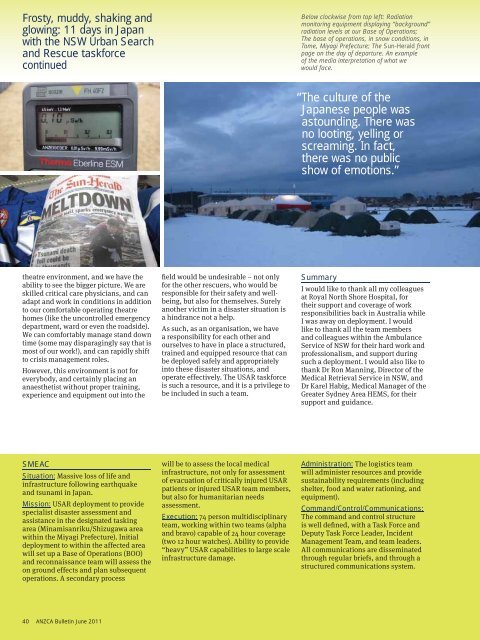ANZCA Bulletin June 2011 - Australian and New Zealand College of ...
ANZCA Bulletin June 2011 - Australian and New Zealand College of ...
ANZCA Bulletin June 2011 - Australian and New Zealand College of ...
You also want an ePaper? Increase the reach of your titles
YUMPU automatically turns print PDFs into web optimized ePapers that Google loves.
Frosty, muddy, shaking <strong>and</strong><br />
glowing: 11 days in Japan<br />
with the NSW Urban Search<br />
<strong>and</strong> Rescue taskforce<br />
continued<br />
Below clockwise from top left: Radiation<br />
monitoring equipment displaying “background”<br />
radiation levels at our Base <strong>of</strong> Operations;<br />
The base <strong>of</strong> operations, in snow conditions, in<br />
Tome, Miyagi Prefecture; The Sun-Herald front<br />
page on the day <strong>of</strong> departure. An example<br />
<strong>of</strong> the media interpretation <strong>of</strong> what we<br />
would face.<br />
“ The culture <strong>of</strong> the<br />
Japanese people was<br />
astounding. There was<br />
no looting, yelling or<br />
screaming. In fact,<br />
there was no public<br />
show <strong>of</strong> emotions.”<br />
theatre environment, <strong>and</strong> we have the<br />
ability to see the bigger picture. We are<br />
skilled critical care physicians, <strong>and</strong> can<br />
adapt <strong>and</strong> work in conditions in addition<br />
to our comfortable operating theatre<br />
homes (like the uncontrolled emergency<br />
department, ward or even the roadside).<br />
We can comfortably manage st<strong>and</strong> down<br />
time (some may disparagingly say that is<br />
most <strong>of</strong> our work!), <strong>and</strong> can rapidly shift<br />
to crisis management roles.<br />
However, this environment is not for<br />
everybody, <strong>and</strong> certainly placing an<br />
anaesthetist without proper training,<br />
experience <strong>and</strong> equipment out into the<br />
field would be undesirable – not only<br />
for the other rescuers, who would be<br />
responsible for their safety <strong>and</strong> wellbeing,<br />
but also for themselves. Surely<br />
another victim in a disaster situation is<br />
a hindrance not a help.<br />
As such, as an organisation, we have<br />
a responsibility for each other <strong>and</strong><br />
ourselves to have in place a structured,<br />
trained <strong>and</strong> equipped resource that can<br />
be deployed safely <strong>and</strong> appropriately<br />
into these disaster situations, <strong>and</strong><br />
operate effectively. The USAR taskforce<br />
is such a resource, <strong>and</strong> it is a privilege to<br />
be included in such a team.<br />
Summary<br />
I would like to thank all my colleagues<br />
at Royal North Shore Hospital, for<br />
their support <strong>and</strong> coverage <strong>of</strong> work<br />
responsibilities back in Australia while<br />
I was away on deployment. I would<br />
like to thank all the team members<br />
<strong>and</strong> colleagues within the Ambulance<br />
Service <strong>of</strong> NSW for their hard work <strong>and</strong><br />
pr<strong>of</strong>essionalism, <strong>and</strong> support during<br />
such a deployment. I would also like to<br />
thank Dr Ron Manning, Director <strong>of</strong> the<br />
Medical Retrieval Service in NSW, <strong>and</strong><br />
Dr Karel Habig, Medical Manager <strong>of</strong> the<br />
Greater Sydney Area HEMS, for their<br />
support <strong>and</strong> guidance.<br />
SMEAC<br />
Situation: Massive loss <strong>of</strong> life <strong>and</strong><br />
infrastructure following earthquake<br />
<strong>and</strong> tsunami in Japan.<br />
Mission: USAR deployment to provide<br />
specialist disaster assessment <strong>and</strong><br />
assistance in the designated tasking<br />
area (Minamisanriku/Shizugawa area<br />
within the Miyagi Prefecture). Initial<br />
deployment to within the affected area<br />
will set up a Base <strong>of</strong> Operations (BOO)<br />
<strong>and</strong> reconnaissance team will assess the<br />
on ground effects <strong>and</strong> plan subsequent<br />
operations. A secondary process<br />
will be to assess the local medical<br />
infrastructure, not only for assessment<br />
<strong>of</strong> evacuation <strong>of</strong> critically injured USAR<br />
patients or injured USAR team members,<br />
but also for humanitarian needs<br />
assessment.<br />
Execution: 74 person multidisciplinary<br />
team, working within two teams (alpha<br />
<strong>and</strong> bravo) capable <strong>of</strong> 24 hour coverage<br />
(two 12 hour watches). Ability to provide<br />
“heavy” USAR capabilities to large scale<br />
infrastructure damage.<br />
Administration: The logistics team<br />
will administer resources <strong>and</strong> provide<br />
sustainability requirements (including<br />
shelter, food <strong>and</strong> water rationing, <strong>and</strong><br />
equipment).<br />
Comm<strong>and</strong>/Control/Communications:<br />
The comm<strong>and</strong> <strong>and</strong> control structure<br />
is well defined, with a Task Force <strong>and</strong><br />
Deputy Task Force Leader, Incident<br />
Management Team, <strong>and</strong> team leaders.<br />
All communications are disseminated<br />
through regular briefs, <strong>and</strong> through a<br />
structured communications system.<br />
40 <strong>ANZCA</strong> <strong>Bulletin</strong> <strong>June</strong> <strong>2011</strong>

















